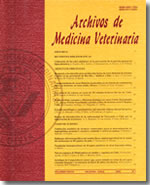Prevalence of lameness in cows from 50 dairy herds in southern Chile
Main Article Content
Abstract
In order to determine the prevalence of lameness, the type of the lesions and the degree of cows lameness a study was carried out in 50 dairy farms from three provinces (Valdivia, Osorno and Llanquihue) of the Xth Región (Southern Chile).
The farms were visited once between April and July, 2003. In each visit all the cows milked at the time of the visit were observed during locomotion. In lame cows all four feet were examined. The degree of lameness was scored in a scale of 1 to 4, being 1 slightly lame and 4 very lame. The data were recorded in an individual recording sheet for each cow. All the data recorded were introduced in an EXCEL data sheet as numerical variables and analysed using the statistical program SPSS 8.0. The farm, province and regional prevalence of lameness were determined, as well as the farm prevalence and total prevalence for each cause of lameness.
A total of 7.501 dairy cows were observed. The mean total prevalence was (9.1%). The four most frequent lesions were chronic lesions of the hoof (19.8%), white line lesions (15.9%), lesions of the wall (10.9%) and overgrowth of the sole horn (10.0%). In relationship to the severity of the lesions found in this study, 53.4% of the cows had a lameness score of 1; 31.86% score 2; 11.9% score 3 and 2.8% score 4. In 43.7% of the cows the hind right foot was the most affected; in 38.4% of the cows it was the left hind foot, in 10.7% the fore right foot and in 7.2% the fore left foot. The most affected toe was the right lateral hind toe with 27%, followed by the left lateral hind toe with 25.8%.
The total prevalence found in this study was lower than the prevalence reported in previous national studies and similar to the prevalence described in countries with similar management and climatic conditions as Chile. It is necessary to educate farmers on the effect of lameness on production and animal welfare.

